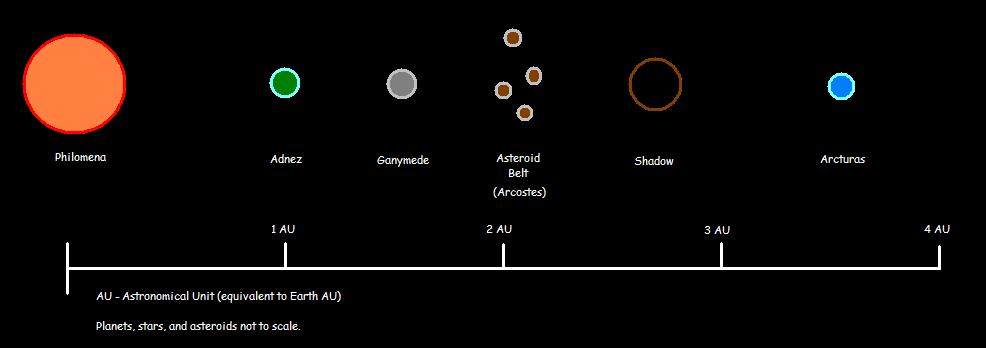Difference between revisions of "Geography"
m (Reverted edits by 129.123.104.8 (Talk); changed back to last version by GnomeWorks) |
GnomeWorks (Talk | contribs) |
||
| (One intermediate revision by one other user not shown) | |||
| Line 1: | Line 1: | ||
| − | |||
| − | |||
Geographic information of all sorts will be here soon. | Geographic information of all sorts will be here soon. | ||
| Line 100: | Line 98: | ||
** [[Turas#Rathyn_Lake | Rathyn Lake]] | ** [[Turas#Rathyn_Lake | Rathyn Lake]] | ||
** [[Turas#The_Gouge | The Gouge]] | ** [[Turas#The_Gouge | The Gouge]] | ||
| + | |||
| + | [[category:Flavor]] | ||
| + | [[category:Geography]] | ||
Revision as of 14:21, 11 December 2007
Geographic information of all sorts will be here soon.
Contents
Geography
This section will give an overview of each planet, and each continent thereon (presuming the planet has continents), as well as a description of the more noticeable geographic features.
General information such as climate will also be listed with each continent.
The Philomena System
The name for the system of planets that Trinity takes place in is the Philomena system, named after its star, Philomena.
Currently, there are three known planets - Adnez, Ganymede, and a planet called Shadow. There is also an asteroid belt, which lies between Ganymede and Shadow. Adnez has two moons, Millicent and Merle, while Ganymede has a single moon, Iyanden.
The image above also shows the fourth planet in the Philomena system, Arcturas. Arcturas will be the setting for the next game, which is slated to begin in mid-September of 2007; information for Arcturas will then be provided on this wiki.
Adnez
Generally speaking, Adnez is rather similar to Earth. It is a comparable distance to its star; has a comparable climate; comparable atmosphere; and comparable flora and fauna. Adnez is dominated by terrain that is also comparable to that of Earth: mountain ranges, grasslands, hills, everglades, forests, lakes, tundras, deserts, and jungles. For the most part, this terrain is natural - only a small percentage of the overall surface of the planet has been magically altered at some point.
Roughly three-quarters the size of Earth, Adnez is crowded but survivable, even hospitable.
- Ashkar
- Chaliraz
- Hills of Minston
- Rafoian Marsh
- Terosian Desert
- Crystal Lake
- Berlian Forest
- The Dividing Range
- The Steppes
- Faehome
- Distarin
- Nanaki Range
- Lake Aoiro
- Forest Otachi
- Lotharie
- Weeping Mountains
- Lotharie Wastes
- Nasyln Range
- Lost Isle
- Molandum
- Caurak Mountains
- Forest of Diarl
- Desert of the Unspoken
- Sarteri
- Vishan Range
- The Lost
- Woodland
- Blue Hills
- Ronkan Lake
- Orcish Heights
- Other
- Isle of Thunder
- Boomerang Isles
- Vesuva
- The Skipstones
- Northlander Reef
Ganymede
Ganymede is an alien world, in every sense of the word. Landmasses here are composed primarily of ferrous metals; flora and fauna are relatively rare and certainly different in many regards from Adnezian plants and animals. Severe thunderstorms plague the planet, a byproduct of its nitrogen-rich environment, drawn to the vast metal plates that serve as the planet's deserts; liquid radiation known as phazon swells from the core, filling the gaps between continents and squelching all but the hardiest life.
Forests of tree-like plants with iron-hard skin and protruding crystals dot the landscape, while foreboding mountain ranges produce frequent avalanches. Chasms and jagged cliffs line the landscape, and rivers of the lightning-blue liquid radiation make huge tracts of land uninhabitable. There is no such thing as a clear sky here - always the thin atmosphere is filled with clouds, which serve as a source of fear for the worlds inhabitants: dark clouds mean only lightning, but blue clouds signify molten rain from slowly-evaporated phazon, a thankfully rare hazard.
Ganymede is roughly the size of Adnez, though slightly smaller. On average, it is colder than Adnez, given its further distance from the local star.
- Western Continent
- Eastern Continent
The Asteroid Belt
Coming soon.
Shadow
Little is known about this planet, as space-faring technology has not developed to the point where it can be reached in a timely manner. However, telescopes have shown that it is a relatively dark planet, and it appears to have some sort of atmosphere, as there is heavy cloud cover; however, it is not known if this atmosphere is habitable.
Arcturas
From space, Arcturas has a light grey appearance; upon entering the atmosphere, the reason for this becomes readily apparent: the entire planet is cloaked in a dense, deep fog, limiting visibility to roughly a mile in any given direction. Occasional breaks in the fog allow for dim sunlight to pour down on the world, but such breaks are rare.
As of 432 CY, little is known of Arcturas: only its inhabitants even know of its existence. From what the inhabitants have found, the world seems to have been broken into fragments, which float above the core of the world - whatever that may consist of. The precise number of fragments orbiting the core is unknown.






